If you’re struggling with your draft, Editors Courtney Harrell and Parul Bavishi will show you how to battle your way to create an explosive Core Event.
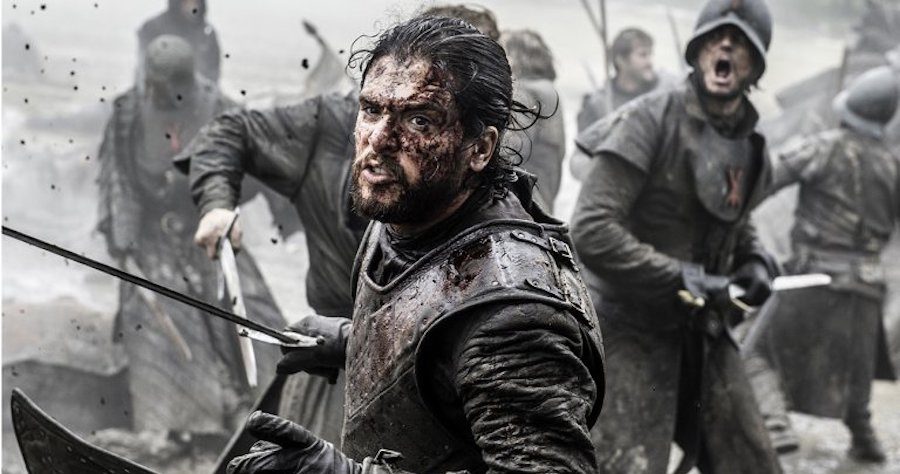
The Core Event helped me supercharge my Story – Courtney
Five years ago on a cold, rainy San Francisco morning, I cozied up in a cafe and began writing a screenplay. Over the course of seven days, my story poured out of me practically writing itself. I loved this story so deeply because of the energy and playfulness it stirred up in me that I was both happy and sad when I wrote the words “The End.”
And then…the story went silent.
CUT TO:
The Year 2019. I always knew I would come back to this script and it finally felt like the right time. I was a writer and an editor now and thought I would dive right back in, finish my story and send it out. No problem.
But it turns out even editors need editors.
When a fellow editor read my story she pointed out that I didn’t have much of an Ending Payoff and I hadn’t nailed my Core Event. Having just finished writing my new ending, I resisted returning to the third act for a week.
And then I realized she was right.
The Core Event suddenly felt like the most important part of any story.
I realized that if the Core Event for my Worldview story didn’t reveal the essential gift of my protagonist in a dramatic way, then the rest of my story wouldn’t come close to working.
I was so excited I shared this insight with Parul and that kicked off a whole discussion about how focusing on the Core Event early on could be used as a powerful editorial tool.
The Core Event is an essential part of my Editor’s toolkit – Parul
For an editor like me, I get my highs from when a writer makes the breakthrough they need and it’s exceedingly satisfying. That is the moment that all the hard editorial work and intense reading pays off. This is why I love being an editor. On the flip side, there are times when you’re trying to help a writer but they can’t understand the problem that you can objectively see.
I was recently working with a writer who had been struggling with their work. They wanted to write a series that could be compared to work by Jo Nesbo, Lee Child and Henning Mankel. They instinctively felt that their story lacked the emotional height but they didn’t know why. We went back and forth over two or three conversations where I realised that they didn’t understand the fundamental aspects of the Story Grid. They had plotted the global crisis and climax but the story wasn’t working.
The breakthrough came when we focused on the Core Event. Together, we tackled two critical questions: Is this the right Core Event for the genre? And, secondly, how does this Core Event compare to Jo Nesbo’s, Lee Child’s and Henning Mankell’s?
Answering those two questions for their Story helped them craft a superb Core Event, and they then worked backwards to set up a beginning and middle section that would deliver an explosive Core Event.
The breakthrough showed me that this core element of a story is a great starting point when helping a writer who is feeling stuck or unsure about the climactic moment. It was also a reminder that reading masterworks and comparable titles while writing and editing is extraordinarily helpful. I now think of the Core Event as an essential part of my editorial toolkit, and I use it to help provide a health check for a manuscript that needs to be injected with purpose.
With this in mind, it’s time to explain what a core event is and exactly how you can use it to reboot your story or if you’re early on, how you can use the Core Event to get clear on your Genre.
What is the Core Event?
When you step back and look at the big picture of a story I don’t think it’s hard to understand why the Core Event scene is so important. The Core Event, as Shawn simply states, is why “people are putting their money down to read.”
No matter what book you’re reading or what movie you’re watching, this is the moment your entire story has been building toward.
I would venture to say that 99% of the time, the Core Event scene will be in the Ending Payoff. In this one very important scene, all the challenges that your protagonist faces and the growth they make will come to a dramatic collision.
If you happen to be writing a series where each book builds on the next, you will need a core event in each book, but you would absolutely want to have one big Global Core Event in the last book as well.
For example, every book in the Harry Potter series has its own Core Event scene, when Harry is at the mercy of Voldemort. In Book 7: Harry Potter and the Deathly Hallows, you will find the BIG Global Core Event for the entire series.
Readers inhaled more than 4000 pages over the course of 10 years waiting for ONE SCENE: The face-off between Harry and Voldemort. The tension built in each book as we waited to find out “Who will live?”, “Who will die?” and “How will it happen?”
If this is the scene your reader has been waiting for, then it’s extremely important to craft a scene that will not just meet but exceed your reader’s expectations.
The Core Event is where your Core Emotion and Core Value meet head-on
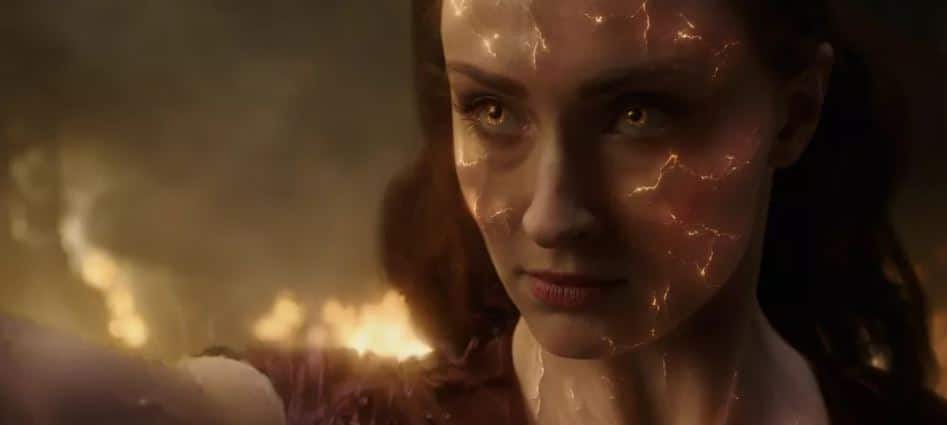
Something incredible happens in your Core Event: your Core Emotion and the Core Value collide and reach a jaw-dropping peak. This is a fiery moment where the reader will see the heart-wrenching potential for a value change.
If you’re new to the Story Grid, perhaps you’re unsure about what the Core Emotion and Core Values are about. Here is a quick recap.
A recap on the Core Emotion and the Core Values
The Core Emotion of a story is what the reader will feel when they read a story, it is the reason they choose a particular type of story. For example in an Action book such as One Shot by Lee Child, the core emotion is excitement. In a society film like Thelma and Louise, the core emotion is intrigue or a sense of rebelliousness. In a Love Story like The Fault in Our Stars, the Core emotion is romance.
The Core Value is a measuring tool for your story; your characters’ actions will instigate a change of value in your story. Without value change, you don’t have a compelling plot.
In an Action story, the protagonist’s arc moves along the values of life, unconsciousness, death, and damnation.

For a ‘deeper dive’ into the Core Emotion and the Core Value, check out Anne and Leslie’s article: “Discover Your Story’s Core“.
Let’s now take a look at the Global Event from Harry Potter and the Deathly Hallows. Let’s see how the Core Emotion and Core Values meet in a dazzling Core Event.
As Harry Potter is an Action story we would expect the Core Event to be the Hero at the Mercy of the Villain. We would also expect the Core Emotion in this scene to be excitement and the Core Value at stake to be life/death.
The Core Event: Harry is standing unarmed, terrified but prepared to die before Voldemort. Voldemort mocks him before he attempts to kill him. Note: At the start of the walk into the forest, Harry put the snitch to his mouth and whispers ‘I am about to die’, the snitch opens to reveal the resurrection stone; Harry is protected and guided by spirits as he walks through the forest.
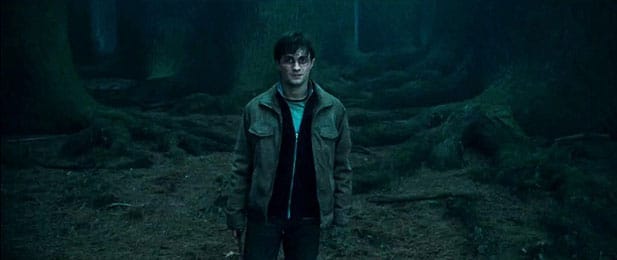
Editor’s note: Some might argue that the Core Event in the Deathly Hallows is the final battle between Voldemort and Harry Potter at the school. But if you examine these two scenes side by side you might understand why I chose the scene in the Forest as the Core Event.
In the Forest, Harry is at death’s doorstep. He has to willingly submit to death in order to save the world. He faces Voldemort unarmed, knowing that he will die. The moment that Harry accepts that he will die, he is close to the tipping point of death. As he walks through the forest, he could run or hide, or in one movement he could fight Voldemort and push himself closer to life and push Voldemort closer to Death. He is on the precipice of change.

Let’s compare this to the final battle scene.
By the time we move to the battle scene at the school, Harry has gained confidence. He has ‘spoken’ to Dumbledore in that place after death; while he’s fighting Voldemort, Neville kills Nagini, the keeper of the final Horcrux. Harry also knows that he is the owner of the Elder Wand, and it can never be used against him. In the final battle scene, Voldemort is closer to death than Harry is.
For a list of all the Core Emotions and Values across the Genres, here is a handy list from Anne Hawley and Leslie Watts.
The Core Event is an opportunity for seismic change
If you’re a keen film buff or reader, you’ll recognize Core Events. Let’s compare the Core Events across the Genres. You can also download the Core Events here.
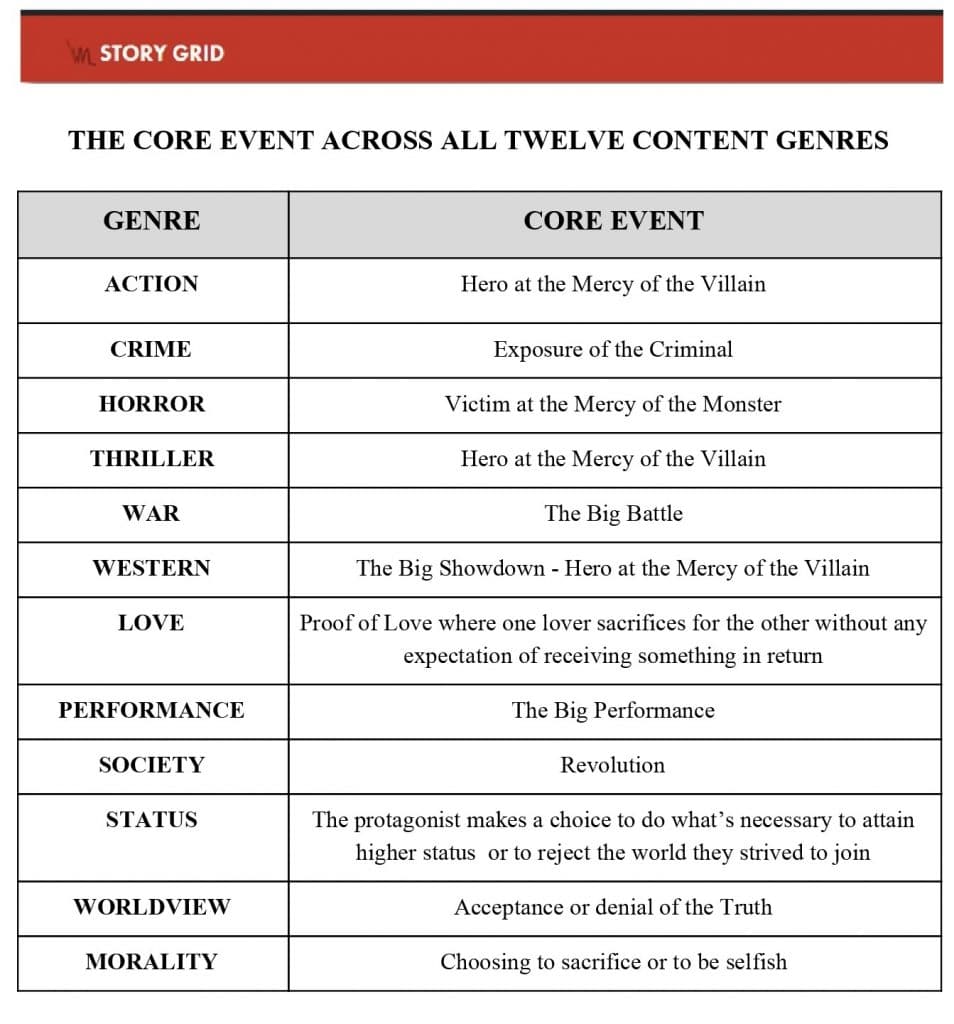
What do you notice about them all?
First, they are the biggest opportunity for a seismic value shift. They are the moments in the story where the protagonist expresses their gifts and moves closer or further away from their goal. By this point in the book, we are so invested in the characters that we care about the outcome, our heart is in our mouth. We’re witnessing the protagonist(s) undergo the biggest value shift of the entire story. If the writer has set it up nicely, we’ll believe that this event could take place; we’ll be rooting for the protagonist to either win or fail.
So, how do you create incredible Core Events?
Not all Core Events are created equal. Films and stories often hit the market and flop, and are never seen again. A writer might express a desire to write an Action story like the Hunger Games, but their Core Event might seem to align with a Worldview Story, which creates a discordant Core Event. In such an example, the story won’t work, something will feel wrong. So how do you create the right Core Event? Here are some steps that might help you.
There are four things you can do:
- If you haven’t identified your Global genre first, understand what genre you’re writing in. From this, you should be able to identify your global genre.
- Using your genre, identify the Core Event for your story. If you’d like a listing of the Core Value & Core Emotions that go with your Event, use this handy list from Editors Anne Hawley and Leslie Watts
- Identify at least 2-3 books in your genre and pick out the Core Scenes in those films or books. Are the characters at a tipping point of change? Are they at the closest or furthest from the goal than they have ever been?
- Use these examples as inspiration to create powerful and innovative events. If you can exceed the reader’s expectations for your genre, you’ll create a story that everyone will remember.
Here are some great examples of Core Events across the genres.
Core Event Examples across the Genres:
The Action Genre’s Core Event: Hero at the Mercy of the Villain
Novel: The Hunger Games by Suzanne Collins
Scene: Katniss and Peeta are the last two contestants alive and seemingly have no way out except to kill each other. Instead of giving the Gamemakers what they want, they choose to die together by eating poisonous berries. As soon as the berries cross their lips, trumpets blare and Claudius Templesmith ends the games and presents both Katniss and Peeta the victors of the Seventy-fourth Hunger Games.
Editor’s Comment: Both Katniss and Peeta are truly at the Mercy of the Villain. Even though they outsmarted the Gamemakers, if the game had not been stopped, they would have died.
The Horror Genre’s Core Event: Victim at the Mercy of the Monster
Film: Train to Busan (South Korean zombie film)
Scene: On a moving train engine, Seok-woo fights with the newly zombified (spoiler alert!) Yon-Suk in order to save the lives of his daughter, Su-an and the pregnant woman Seong-kyeong.
Editor’s Comment: I loved this movie because the progressive complications just don’t stop. I also appreciate that despite being a horror film, there is a Worldview internal arc for the protagonist. While this may not be the most inventive Victim at the Mercy of the Monster scene, there is plenty of tension and the outcome is surprising but inevitable.
The Crime Genre’s Core Event: Exposure of the Criminal
Film: Catch Me If You Can
Scene: Carl Hanratty, played by Tom Hanks, confronts the fraudster, Frank Abagnale, at his printing press in France.
Editor’s Comment: This scene is particularly compelling, because we have seen Frank chasing Carl for a long time and failing to capture him several times. We can also see how desperate Frank has become – his crimes have not made him happier. Frank confronting and exposing the criminal is almost like redemption for Frank who has so much talent and is wasting it away on criminal activities.
The Western Genre’s Core Event: The Big Showdown
Film: Django Unchained
Scene: In Quentin Tarantino’s true form, the big showdown is a bloody mess. Django returns to Candieland to free Broomhilda. Before they leave, Django enters Calvin’s mansion and bullets fly in all directions. Django kills just about all of Calvin’s henchmen before igniting dynamite and blowing the mansion to bits.
The Thriller Genre’s Core Event: Hero at the Mercy of the Villain
Novel: The Girl With the Dragon Tattoo by Steig Larsson
Scene: Blomkvist the journalist finds himself at the mercy of the serial killer Martin Vanger
Editor’s Comment: Blomkvist has been searching for the serial killer for a while. When he confronts him, he is quickly tied up, and while preparing to kill and possible rape or assault him, we have an insight into Martin Vanger’s twisted mind and understand that the crimes started many years. This is a particularly dark Core Event.
The War Genre’s Core Event: The Big Battle
Film: Zero Dark Thirty
Scene: SEALs raid Osama bin Ladin’s compound, fighting and killing a number of people including bin Ladin.
The Society Genre’s Core Event: The Revolution
Film: Thelma & Louise
Scene: At the edge of a cliff, Thelma & Louise are cornered by the Police and they choose to control their own fate and avoid prison by driving off the cliff
Editor’s Comment: The revolution scene is particularly tragic or empowering depending on your perspective. By making a choice not to endure any more oppression they are free. But the cost is more than the women should have to bear.
The Love Genre’s Core Event: Proof of love
Novel: The Fault in Our Stars by John GreenScene: At Gus’s funeral, Hazel finds out that Gus had secretly asked Van the author Peter Van Houten to come and apologise, as he knows that it’s important to Hazel. He does this without expecting a reward. She reads the obituary he had written for her: He says that getting hurt in this world is inevitable, but we do get to choose who we allow to hurt us and that he is happy with his choice. She ends the book saying that she is happy with her choice too.
Editor’s Comment: The innovation in this story is in how the proof of love is delivered after Gus’s death.
The Performance Genre’s Core Event: The Big Game/Big Performance
Film: A League of their Own
Scene: The Peaches and the Belles meet in the World Series. Kit hits the ball and scores the winning run by knocking her sister Dottie off of home base
Editor’s Comment: This Core Event moment exceeds the expectations of the typical Big Game because the writers pit two sisters, on opposing teams, against each other. The outcome is a heartfelt moment when Dottie “drops” the ball and Kit’s team wins. By doing this Dottie salvages their relationship because winning means everything to her little sister, Kit.
The Worldview’s Core Event: Acceptance of the World as it is
Novel: The Alchemist by Paulo Coelho
Scene: At the pyramids, Santiago is robbed but realises that the treasure was at home all along. He is happy despite having lost everything, he finally understands the truth and realizes how he has grown in maturity.
Editor’s Comment: This book is littered with Santiago’s snippets of wisdom; he shares his maturity of worldview as it happens, and as the book progresses.
The Morality Genre’s Core Event: Choosing to sacrifice or to be selfish
TV Series: House of Cards, Season 1
Scene: In Episode 11, Peter Russo threatens to expose Frank Underwood’s secrets, and Frank stands to lose everything he has worked for. He kills Peter and makes it look like a suicide. This leads to his plans for the Vice President going ahead.
Editor’s Comment: The Core Event for this series is strongly linked to the Status Genre, and it pulls both the genres together in this scene, showing us Frank’s ascent to a higher status and his spiraling moral descent.
The Status Genre’s Core Event: Gain or Loss of Status as Protagonist makes a choice
Broadway Musical: Annie
Scene: After meeting the president, and not finding her ‘real’ parents, Annie chooses to be officially adopted by billionaire Daddy Warbucks.
Editor’s Comment: Annie’s rise in status is all the more poignant because of her innocence; all she really wants is love and a home.
Now that you have your Core Event . . . where do you go next?
Before you move to the next step, make sure that you have used the steps above to create a stronger, clearer Core Event in your own story.
The next step is to move to the beginning of the story. Let us explain why.
The Beginning Hook and Ending Payoff mirror each other. Once you know what you need in your Core Event, you have to make sure that you have set this up in the chapters preceding it. The next natural step in revising your story is, therefore, to go back to the beginning.
We suggest that you start with the Inciting Incident where your protagonist’s normal life is knocked out of balance. Your protagonist will want to redress the imbalance but you will ensure that they experience obstacles and opportunities that force them to grow into a strong enough character ready and able to face that Core Event moment.
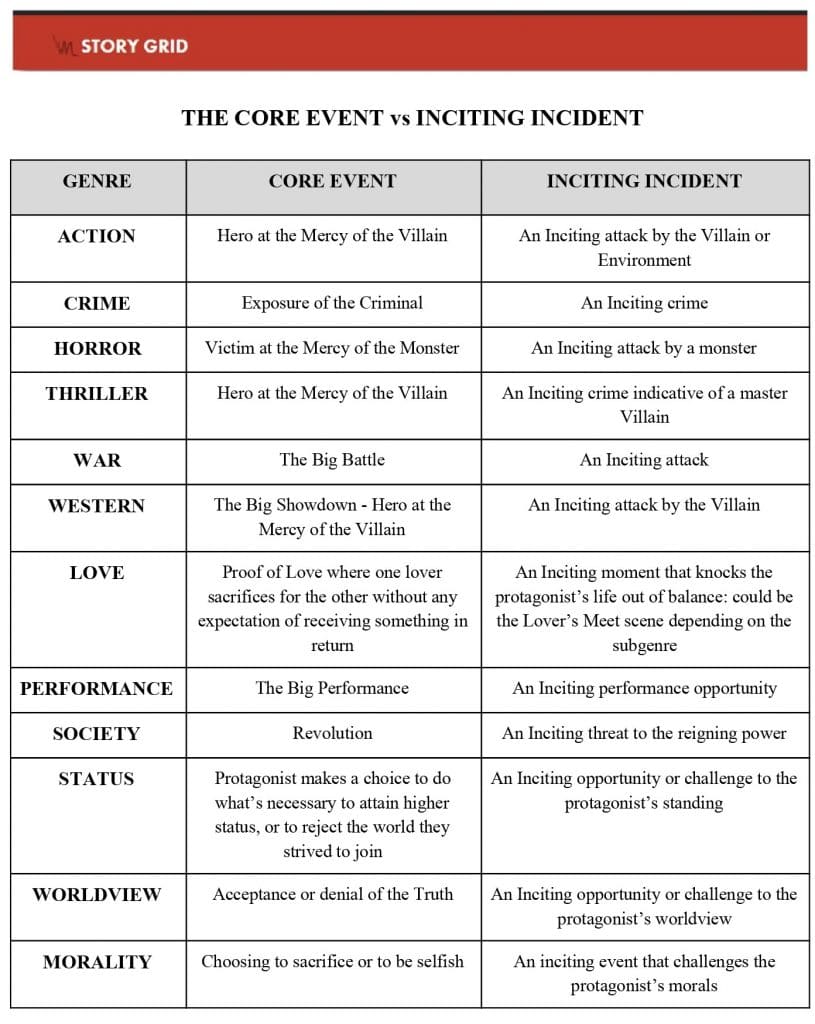
Having clarity about both your Inciting Incident and your Core Event can open up a ripple of ideas that need to set up and pay off your story between those two points. You can download our one-pager to compare the 12 Content Genre Inciting Incidents and Core Events side by side.
A Final Note
Whenever you’re stuck at any part of your story, take a look at your Core Event and see how well it stands up against your favourite stories in your Genre.
Thinking about your Core Event scene early on can also help you get clear on your Genre. Ask yourself “What kind of story do you want to tell?” “What kind of core event scene do you get excited to write?” “What moment are you building up to?”
And then challenge yourself to innovate on what has come before you. Don’t be afraid to write it a few different ways. Each time you’ll get closer to a Core Event that your readers will never forget.